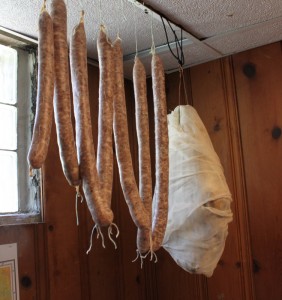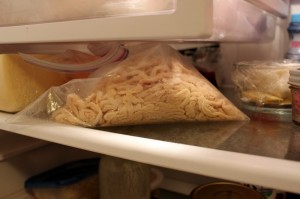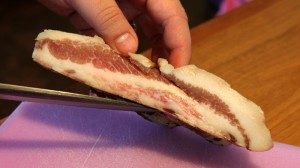On a picturesque 65 acres in east central Ohio, there lies Jorgensen Farms, a biodynamic animal and vegetable operation. Proprietor Val (pictured below in blue) works the land guided by her distinguishing palette and eye for pleasing design. She builds vibrant soil through careful crop rotation and pasturing. Perhaps the most recognized crop is her mint grown especially for central Ohio based Jeni's Splendid Ice Cream's Backyard Mint flavor.


 You may click on pictures to enlarge them.
You may click on pictures to enlarge them.
I attended the Ohio Lamb Chef's Day at Jorgensen Farms one cold and rainy day this May. The event included tours and tastings aimed at educating restaurant chefs. We walked through herb gardens near the farm houses and viewed sheep out to pasture on rolling hills. Two chilly day-old lambs visited in the arms of flower grower and livestock helper Roger Genter.
The meat of the event was a fascinating demonstration by Dr. Paul Kuber, associate professor of Animal Sciences at Ohio State University. He expertly butchered a lamb into cuts usable by restaurants and home cooks, sharing anatomy and culinary tidbits throughout. A six course sampling meal followed, using some of the cuts demonstrated.
At the end of the lamb cutting, a large bowl of scraps was left. Kuber shared that these could be used for sausage or other charcuterie. When the June Charcutepalooza challenge, stuffing, was announced, I knew what I had to make: mint lamb sausage, inspired by Jorgensen Farms.
Lamb mint sausage makes good use of the abundant mint and garlic scapes in our own backyard. We chose Ohio lamb and pork to keep the recipe local. The binding liquid included some of our own apple cider vinegar made last autumn.



As we have been stuffing sausage for a few years, the process runs quickly and smoothly now. Alex and Lil do most of the meat handling while I clean up behind them. From grind to bind to stuffing, a batch only takes about thirty minutes.
I served the sausage tonight with barley risotto and wilted homegrown greens. I highly recommend this hearty and healthy combination. It warmed us on a unseasonably cool evening, reminiscent of the chilly day I spent at the lovely Jorgensen Farms.
Mint Lamb Sausage
Makes 10 7 inch links
2 pounds lamb shoulder, boned 1 pound pork shoulder, boned 0.9 oz kosher salt (a hair less than 2 tablespoons) 1/3 cup finely chopped fresh mint 1 1/2 tablespoons finely chopped fresh young garlic scapes 1/4 cup apple cider vinegar 1/4 cup water hog casings
1. Grind lamb and pork with a large die. 2. Transfer to a mixing bowl. Add salt, mint, and scapes. Mix with batter paddle to combine. 3. Slowly pour in apple cider vinegar and water while mixing on low speed. Continue mixing until sausage binds or becomes very sticky, approximately 5 minutes. 4. Stuff into hog casings and make links.
[/print_this]









 book will be nearby for recipes and advice on all types of curing. You will have a meat grinder and possibly several other sharp and dangerous tools.
book will be nearby for recipes and advice on all types of curing. You will have a meat grinder and possibly several other sharp and dangerous tools.
 and
and  attachments for our Kitchen-Aid and am in the sausage making business. I purchased enough hog casing from
attachments for our Kitchen-Aid and am in the sausage making business. I purchased enough hog casing from


